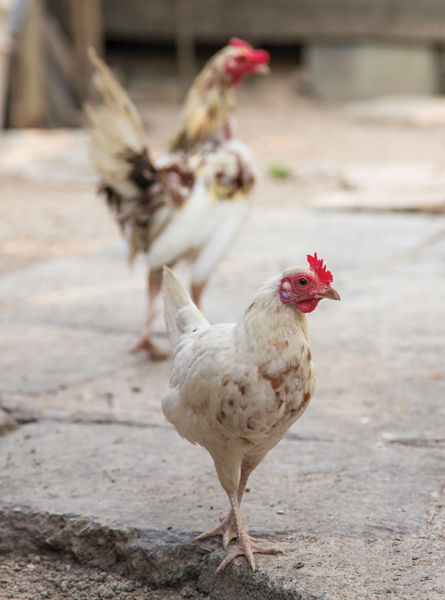Backyard Birds
by Anna Herman
Backyard chickens have a long history of coexisting with humans in cities, towns and villages worldwide. The 1917 Poultry Gazette ran the following ad:
“Even the smallest back yard has room for a flock large enough to supply the house with eggs. … They require little attention only a few minutes a day. … A chicken in every yard!”
Chickens require little more than any household pet. Food, water, and a place to keep warm, dry and safe from predators. A sturdy modified shed, doghouse or playhouse lined with some combination of straw, hay and pine bark bedding is perfect for a small flock.
As long as there is a way in and out for the chickens, a way to clean out the coop and an easy way to collect eggs, you are all set. Do-it-yourselfers can find many plans online for coops and runs, and there are numerous places to buy a kit or preassembled unit nearby.
There is enough room in a 4-foot-by-6-foot coop to comfortably sleep six to eight birds, as long as they have about 10 square feet per bird outside to peck and scratch during the day. Chickens return during the day to their indoor nesting boxes to lay, and again each night at dusk to “go home to roost.” Chickens are especially vulnerable to nighttime predators. Consider an investment in a solar powered automatic door, or plan to be home at dusk to close them safely in. Chickens like to perch, and most would sleep high in a tree branch in the wild. Provide a branch, bamboo pole or large dowel inside the coop and within their run to serve this purpose.
Their daily portion of feed can be dispensed onto the ground, or in any of variety of feeders. Other daily chores include checking and refilling water as needed and—of course—collecting eggs. Chickens begin to lay when they are between 4 to 6 months old (they are called “pullets” until then), and most will lay three to six eggs per week through much of the year.
Free range birds can make a mess of vegetable and flower garden beds, but with strategic fencing and row covers they can be allowed access from time to time. Alternatively, create a well secured “run”—a large, enclosed place to safely leave chickens outside all day. My run has hardware wire cloth buried around the perimeter, and walls and a ceiling made from chicken wire. Hawks, foxes, raccoons, opossums and many breeds of dogs will find a way to massacre your birds given a chance. Many dogs, however, can coexist well with backyard poultry.
Many breeds of ducks are also excellent egg layers and very hardy for winter. They are a bit messier and require the water to be changed much more often. I added an additional “nipple type” waterer for my chickens, so they wouldn’t have to put up with the dirty duck water, but they still prefer to share. I did put in a small pond in the run—not essential—but ducks sure do love to dunk (and it’s fun to watch). The ducks and chickens—raised together—are one flock and sleep and eat together.
Poultry owners should familiarize themselves with illnesses and possible disease transfer, and should take precautions with migratory birds sharing your chickens’ feed. Take special care not to spread disease to your flock by transferring contaminant on your shoes and clothes after visiting and interacting with other flocks.
In the winter, consider your siting; insulate with bales of straw and bags of leaves. One winter when I was down to only one hen due to a series of hawk attacks, I resorted to providing my down vest to the shivering hen and she survived to lay again. Use an electric base for the water dispenser to keep the water just above 32 degrees—essential to ensure fresh water all day during cold winter months.
If possible, site your coop near your compost pile to streamline coop cleaning;
they’ll love the access to food scraps and garden weeds along with the worms. City chickens need their coops cleaned often—especially in warm weather—for your neighbor’s sake if not yours. Rats and mice are an issue if easy access to stored or spilled chicken feed is not addressed.
Chicken owners—especially we scofflaws in Philadelphia—should do our best to model “best practices” and perhaps we can return to the happier days before 2004 when Philadelphians really could have a chicken in every yard.
Anna Herman is a garden educator who raises chickens, ducks, bees, fruits and veggies in her Mount Airy backyard.










